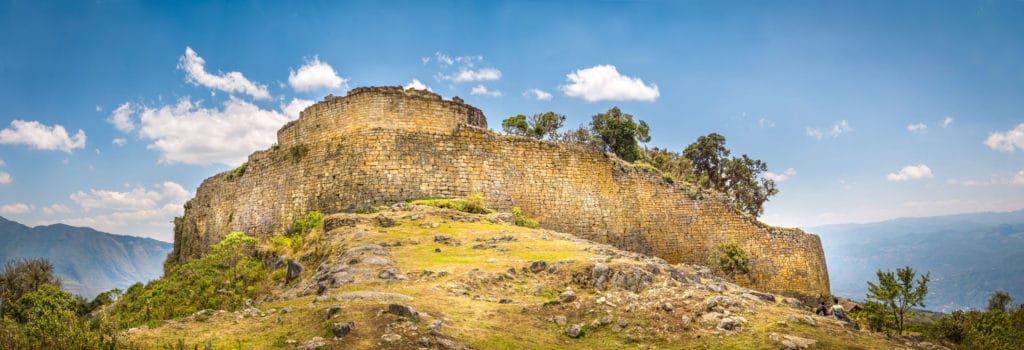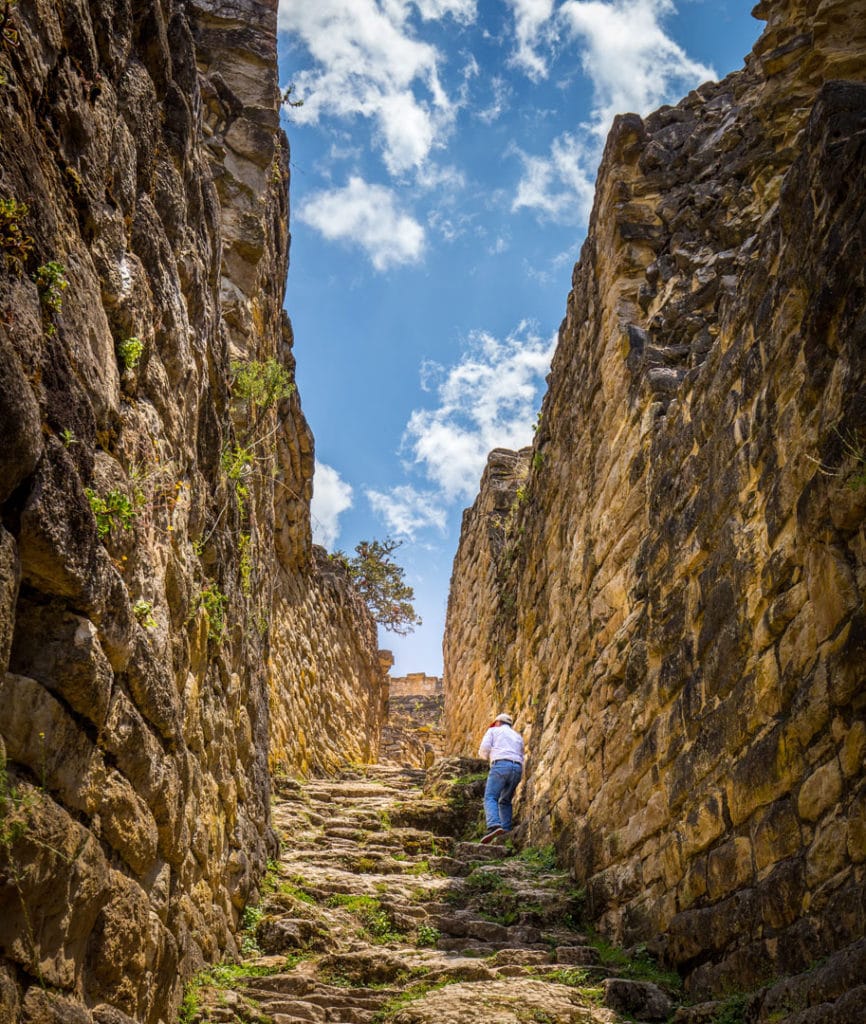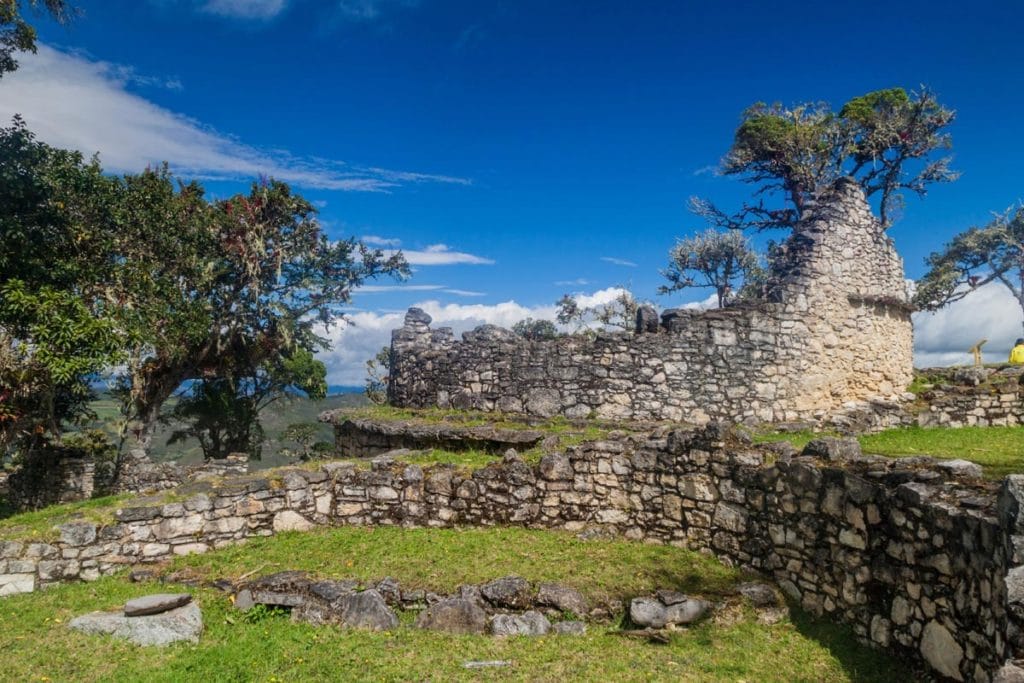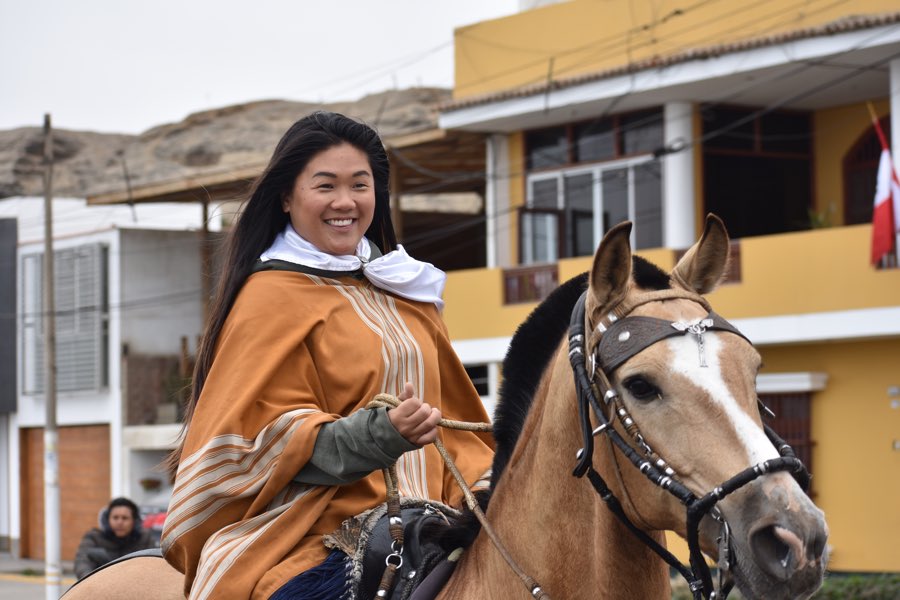The fortified city of Kuelap is located in the Amazonas region of Northern Peru, on the top of a mountain. It was named Cultural Patrimony of the Nation in 2000 and is considered the “Machu Picchu del Norte”. In 2008, it was recognized as one of the seven wonders of Peru.
1. Kuelap in some figures
1843: its rediscovery
3000 m: the altitude at which it is located
7 hectares: its total area
400: the number of round houses in Kuelap
3,000: the number of inhabitants at its peak
20 m: the height that can reach the walls that surround it
708,000 m3: the volume of stones used to build the Kuélap site, 3 times the volume of the Kheops pyramid in Egypt
2. The construction of Kuelap
Kuelap was built by the Chachapoyas between 500 and 800 AD., which means 600 to 900 years before Machu Picchu, built by the Incas.
Kuélap’s architects supervised hundreds of specialists. There were stonemasons, masons and carriers for water, stones and mud. In addition, there was a multitude of farmers whose production was only used to feed the workers.
The site was occupied until the XVI century.
3. The rediscovery of Kuelap
The owners of the Kuelap estate unjustly included the land of the villagers of Tingo Viejo in their complex. This dispute was the origin of the rediscovery of Kuelap.
In 1840, the judge of Chachapoyas, Juan Crisostomo Nieto, was in charge of this case. During his field visits, he discovered that strange stone walls occupied a large part of the land. But it was only a superficial comment: they were just walls.
In 1841, the inhabitants discovered that these walls were colossal and contained something. But they thought it was a funeral place and they preferred to keep quiet. They did not want to desecrate the place and suffer the curse of mummies.
In 1843, during a new visit of Don Juan Crisostomo Nieto, one of the villagers told him about his discovery and the judge wanted to go there. After a day of searching, they discovered the main entrance and the judge decided to enter. He discovered among the vegetation buildings of several centuries old: Kuelap reappeared in the eyes of the world. It was January 31, 1843.
4. Fortified city or fortress?
Archaeologists have long thought that Kuelap was essentially a fortress. But according to their latest studies, they have determined that the religious aspect is even more important. That is why today it has the name of a fortified city.
5. Reaching the city of Kuelap
From Chachapoyas you have several possibilities to get to Kuelap.
- Either you take a car, which will then take around three hours from Chachachapoyas (and still today is the only possibility on a Monday, because on Monday the cable car is under maintenance).
- Or it is a one-hour drive to Tingo Nuevo and then the cable car to Kuelap (about a 20-minute ride).
Either way you go to Kuélap, you will reach the Malca. If you have not purchased your ticket yet, this is where you will have to take it. It will cost you 20 soles, or € 6.
From there, you will have to walk 2.5 km to reach the site. Before starting the climb, you can go to the bathroom one last time, very clean, or look at the orchid garden.
The climb to the fortress has been facilitated since 2014 when the road was paved. Every 500 m, there is a shelter to rest, take shelter in case of rain or simply enjoy the view. However, do not underestimate the altitude of 3000 m and take your time.
6. The arrival in Kuélap
You arrive at Kuélap on the south side, where the wall is the most impressive: it measures more than 20 m in height.
Today, we know that the walls were not built directly at this height. It is the superposition of “layers of life” that gives them their current size. In fact, as often in pre-Inca civilizations, the Chachapoya people buried their house after the death of the head of the family and rebuilt again on top of that.
7. Explanations of the site
The entrance of the site
The entrance of the site itself is done today by what is called the entrance N° 3. At that time, it was the entrance of food and water delivery. On the way up, we can also see traces of hooves of llamas marked on the stones.
The entry N° 2 was to be used by women who carried water and by villagers returning from the fields. It is currently being restored. In addition, this leads to a cemetery outside the citadel. Some say it was here that the Chachapoya fled under the Inca’s seat.
As for the spectacular entry N° 1, which can be seen in all the official photos, it is closed to the public for security reasons. In fact, it is maintained by wood plots at the moment, as of the risk of collapse. Restoration work has already begun. Its reopening, scheduled for early 2018, would simplify visits.
In fact, the walls of the different entrances to the Kuélap citadel get always more narrow as you continue to enter. At he end only one or two people can enter at once. This was an excellent defense in case of attack.
The first level
Round houses
Once inside, we are on the first level of the fortress, where people lived. This is where most of the round houses are located, exclusive to the Chachapoya culture.
Only one was rebuilt with a high thatched roof to imagine the town. However, it was destroyed because very little is known about how these houses were built. Therefore, it has been argued that a reconstruction can completely distort history. In addition, the Peruvian government does not want to rebuild historic monuments, just to keep them in good condition to visit.
On this first level, there were approximately 420 houses. But after the investigation, it is believed that there must have been more houses that collapsed.
In each house lived a large family of about 8 people. We find :
- the traces of large grinding stones,
- a place to make fire sometimes, although we think that the kitchen in general was in contiguous places,
- at least 2 or 3 graves.
This part of the citadel was not cleaned. As a result, it is still covered with vegetation, trees, bromeliads and wild orchids. The atmosphere is mystical.
The Inkwell or Templo Mayor
It is to the south, behind the famous entrance No 1.
The ruins have been restored where they were necessary to keep them in their current state and not let them deteriorate. A ruin of a round house tells us that the walls measured 4 meters and contained openings similar to windows.
Here is the “Tintero”, a monument in the shape of an inverted cylinder. Inside, we find remains of bones. It is believed to be a highly religious place, used primarily for human sacrifice. The most amazing? The bones dating from before Christ were found there. This would mean that the place has been inhabited for much longer than previously thought.
On an outer wall of the Inkwell, one can see a face that seems to smile: it is a feline, one of the Chachapoya gods. There are also 14 other faces in the corridor of entrance number 1 showing cats and snakes.
The second level
Only the most honorable people in the city lived there.
El Torreon
This Chachapoya tower is located to the north and serves as a watchtower. This is the highest point of the citadel, but you can not climb.
The Castle
It is one of the five rectangular buildings of the citadel. According to the archaeologist Arturo Ruiz Estrada, it could be used as an operations room, where trepanations and other interventions were carried out.
The Inca remains
A rectangular ruin dating from the Inca – Chachapoya occupation was found in a circle. On this level, there are 4 other ruins of Inca buildings.
Also, we can not visit the south side of this level because we discovered an Inca tomb.
8. Funeral traditions
As indicated above, the Chachapoyas buried their dead in the house. Then they covered the land and rebuilt it.
The tombs consist of round holes about 50 cm in diameter. They are only 1 m deep. These holes were covered with a flat stone placed on it.
The ritual of the Chachapoya consisted in first removing the viscera from the body. Then they positioned the latter in a fetal position. Then put ropes around it and put it in a bag that was decorated with a face. The tomb was also full of ceramics and fabrics. There is no gold or silver like in the tombs of the Incas. The Chachapoyas believed in rebirth. Therefore, it was logical to bury someone in a fetal position on mother earth while waiting for her to be reborn.
The houses of the most important people were decorated with rhomboidal or zigzag friezes to represent the deities of Chachapoya: feline, snake or condor.
9. The Kuélap massacre
The corpses of men of all ages (children, youth, adults, the elderly) have been found inside and outside a house. The fact that they were not buried according to funerary rituals suggests that there was a massacre. In addition, they were killed by stones in the skull. According to Alfredo Narváez, it was not the work of the Incas or the Spaniards: there is no sign of a sword or a weapon, the arms of the conquerors. This would be the result of a conflict between local families.
After the massacre, Kuelap was burned.
10. Site management
If Kuelap was rediscovered in 1843, it was not until 1979 that the Ministry of Culture began to really take care of the fortress by installing security guards to monitor access and protect the site.
Several governments from different countries, including China and Japan, have helped conduct research of Kuelap. However, until today, only 20% of the area has been excavated.
It is incredible that such a fortress can exist and that we know very little. There are so many questions that have gone unanswered, but does not that keep the myth?
11. Practical information
Dress to go to Kuelap
To climb Kuélap, dress in layers to easily remove and add thicknesses.
Plan what you need for any type of weather: windbreaker, umbrella, wool vest, hat. And do not forget sunscreen and a bottle of water. The climate changes rapidly in Kuelap!
How to get to Kuélap
By car
It takes approximately 2 hours and 30 minutes to get from Chachapoyas to La Malca, the Kuélap parking lot.
Next, you will pass through the towns of Tingo, Nuevo Tingo, Choctamal, María and Longuita.
By foot
The climb starts at Tingo Viejo. Then, you will take a hiking trail of 8.9 km that runs through the mountains.
You must be well equipped: rain gear, good walking shoes, but also hat, sun block and water bottle. There is no tree to protect from rain or sun.
The trip is mystical. When we climbed, there were low clouds, so we moved through the fog. Immediately we are transported to the time of Chachapoya, and immediately we understand their nickname: the warriors of the clouds!
When the sky is clear, we can see that the road is quite narrow and steep.
After a moment we can see Kuelap, majestic, on the opposite side of the mountain. But it will turn around for 45 minutes before you can reach it. We understand then that it was difficult for the Incas to conquer this fortress of more than 1,000 years old.
By cable car
Since March 2017, the cable car has finally been created, which had been spoken for more than 10 years in the region.
For 20 soles, round trip, you can go up to Kuélap in 20 minutes from the town of Tingo Nuevo. In addition, the view from the cable car is impressive!
With a tour
The trip to Kuélap from Chachapoyas, which includes a tour, guide, food, cable car and the entrance to the site, costs 110 soles (30 €).
With Turismo Explorer: Jirón Grau Nº 549 – Plaza Mayor, Chachapoyas, Amazonas, Peru








